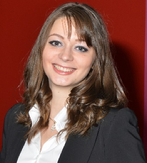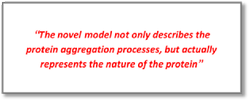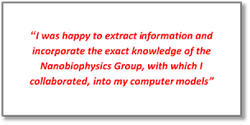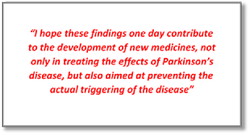 This thesis deals with α-synuclein, the protein known to form aggregates commonly found in the brain of patients with Parkinson’s disease (PD). A coarse-grained model is developed that simplifies the protein into a short chain of five particles. These can assume different shapes. ‘We followed the protein’s real structure and behavior,’ Ioana Ilie says. ‘The novel algorithm allows the protein to adapt its shape, structure and interactions, for example in fibrils or amyloids. By bringing in this chameleon-like behavior, the model not only describes the protein aggregation processes, but actually represents the nature of the protein. This matches experimental findings.’
This thesis deals with α-synuclein, the protein known to form aggregates commonly found in the brain of patients with Parkinson’s disease (PD). A coarse-grained model is developed that simplifies the protein into a short chain of five particles. These can assume different shapes. ‘We followed the protein’s real structure and behavior,’ Ioana Ilie says. ‘The novel algorithm allows the protein to adapt its shape, structure and interactions, for example in fibrils or amyloids. By bringing in this chameleon-like behavior, the model not only describes the protein aggregation processes, but actually represents the nature of the protein. This matches experimental findings.’

The work of Ioana Ilie in the Computational Biophysics (CBP) group was part of the research programme “A Single Molecule View on Protein Aggregation,” as initiated by the Foundation for Fundamental Research on Matter (FOM) within the Netherlands. Led by UT-professor Vinod Subramaniam PhD-researchers from the universities of Twente, Leiden and Amsterdam collaborate, together with AMOLF scientists.
‘Approaches are combined here - be it biological or chemical, be it theoretical, experimental or using simulation techniques,’ Ioana says. ‘Twice a year we shared our findings, inspiring one another along the way. The Brownian Dynamics simulations which I designed, shed new light on some important questions regarding the internal structure of the protein, the way fibrils are formed, and what their properties are. I hope these findings one day contribute to the development of new medicines, not only in treating the effects of Parkinson’s disease, but also aimed at preventing the actual triggering of the disease. ‘
Help nearby
Apart from collaborating with other universities, Ioana found help nearby, in particular by addressing her colleagues of the Nanobiophysics Group. This group participates in the Mesa+ Institute for Nanotechnology as well as in the Mira Institute for Biotechnology and Technical Medicine.

‘Situated close to our laboratories, I regularly walked over, asking for advice,’ she says. ‘Their expertise on biological aspects involving structure and dynamics of α-synuclein, was of great value. I was happy to extract information and incorporate their exact knowledge into my computer models. This feature is one of the distinctive advantages of Mesa+, I believe: the openness and readiness to share additional information and insights with fellow researchers.’
Picture publication
Ioana’s first publication was a featured article in the Journal of Chemical Physics, appearing on the cover of this journal. Ioana: ‘Appearing on the cover of this journal was astonishing. I was able to capture a unique picture, using the first version of the algorithm describing buckyball-like protein processes. After a long silence from the editorial office, the very day I heard the picture would get published, I could actually see it with my own eyes. That was as unexpected as it was a pleasant surprise.’
Post-doc

The 1,5 years to come, Ioana will work as a post-doc within the Group, taking her work further, including features on an atomic level into her algorithms. Alongside this she is writing a proposal to pursuit her academic career at the University of Switzerland, working on similar research subjects.
Ioana: ‘For this moment I am happy in academics. During the PhD project I developed both as a researcher and as well as on a personal level. Apart from the skills and knowledge, I gained confidence in interacting with people, making it more easy to approach colleagues and partners, building powerful collaboration networks.
‘As a chairman of the PhD network P-NUT, within the University of Twente, I further improved my organizational skills. I thoroughly enjoyed this work which contributed to a good balance between work and personal life. This balance is, from my point of view, very important.’
